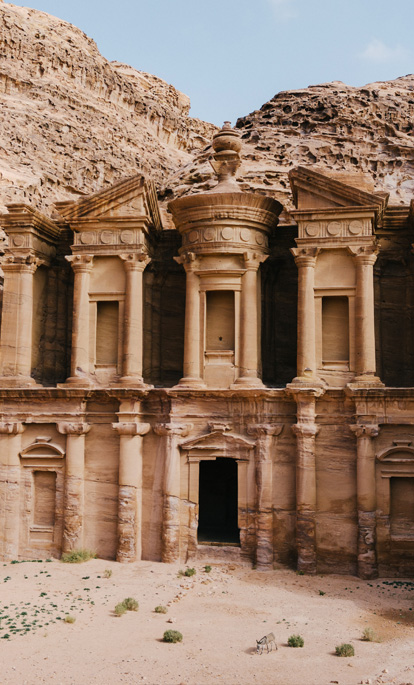The best time to visit Jordan largely depends on what you’re after. If it’s outdoor adventures across ancient ruins and up Bedouin footpaths, the cooler months around spring and autumn (March to May and September to November) are your best bet. This is when temperatures are toasty but not sweltering, humidity is pleasant. And in the spring, thanks to the winter’s rain, the forests, hills and valleys that run down the country’s spine spring to life with wildflowers and colourful flora. The only drawback is the desert wind, known as the khamseen, which blows each spring across the Middle East. But, despite raising temperatures by 10°C, it rarely lasts longer than a few days.
If you like your summers scorched, plan a visit during the country’s hot season (June to August). With 13 hours of sunshine, you can expect temperatures of 40°C in Amman and 45°C at the Dead Sea and Aqaba. Be prepared for early starts though, as although summer sees fewer tourists thanks to these scorching temperatures, you’ll want to be up early to beat the midday heat. Foodies and culture connoisseurs will be happy though – not only is summer when the majority of the country’s festivals take place, it is also when fresh fruits such as watermelon, figs and dates are in season.
Jordan is best avoided during the winter months too. While southern Aqaba and the northern shores remain warm (temperatures vary little from 24°C), in Amman and Petra, lows of -8°C and snow aren’t uncommon. However, if you come prepared with cold weather gear, you will be able to enjoy reduced hotel rates and have the majority of Jordan’s tourist spots to yourselves.
Wadi Rum
Wadi Rum is everything you expect of a desert. Think: narrow gorges, natural arches and towering cliffs. Fortunately, it boasts a pleasant climate all year round too (averaging 14°C in January and 34°C in July). Its peak seasons are spring and autumn, when average temperatures range from 20-30°C and daylight continues for 8-11 hours straight. If you can hack the hot, dry heat, summer can be the best time to visit Wadi Rum if you’re after an authentic crowd-free experience. But be warned, temperatures have been known to creep up to 40°C.
Aqaba and the Dead Sea
Often considered a stop-off en route to Wadi Rum and Petra, Aqaba is the perfect place to unwind and chill. The temperature, however, knows no such word. During summer, temperatures rarely dip below 35°C, while in winter they stay put at around 20°C. The spring season is the region’s busiest – for good reason. Tourist sites such as Ein Gedi Nature Reserve are blooming, restaurants are full of life and the Masada climb is more than pleasant, thanks to the gentle sea breeze. In the height of summer, the Dead Sea is the country’s most comfortable spot, temperature wise. The sea is cool and inviting (particularly for diving), humidity is low and UV levels are significantly lower than other Jordan holiday destinations. If you are in the mood to hike and explore, however, the Dead Sea area is best visited during the cooler months.
Amman
Amman is a must-see on any Jordan holiday, particularly in March, April and May when the weather is at its most temperate. Temperatures hover in the low to high twenties during the day and around 10°C at night, making it the perfect climate for wandering round the capital’s Citadel, Roman ruins and leafy suburban districts. It is also the time of year when most of the city’s events take place, such as the Dead Sea Ultramarathon and the Amman International Theatre Festival. The city is best avoided in winter (roughly December to February) though, as it can become desperately cold, with biting winds, rain showers and snowfall.
Petra
The great Ancient City, located in southern Jordan, enjoys a warm and temperate climate. The average temperature is 25°C (ranging from 14°C in January to 35°C in July) and annual rainfall is 99mm. The best time to visit Jordan’s most popular attraction, however, is in spring – May in particular. Temperatures rarely rise over 30°C and rainfall is at its lowest, making sightseeing a comfortable activity throughout the day. Don’t expect to have this new Wonder of the World to yourself though, as springtime is the most popular tourist season.














